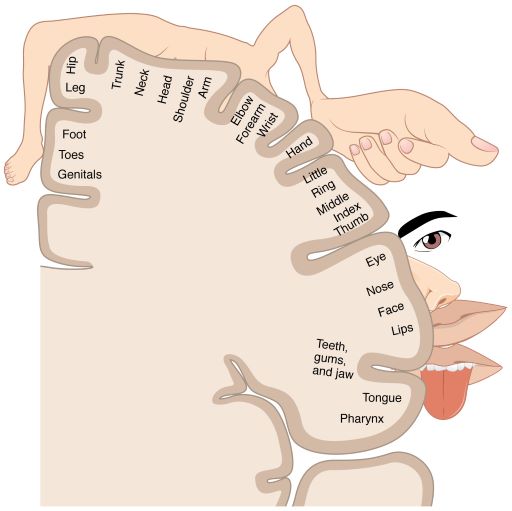Neurological events such as a stroke, can cause changes in feeling or sensation, with sensation retraining a tool to address this. If a stroke damages the part of the brain that processes pain, temperature, or touch, sensation changes can occur.
If you have change of sensation after a stroke, you might hear your therapy team talk about the sensory homunculus. The sensory homunculus is a map of the parts of your body that you can feel with. This video explains more about the sensory homunculus.
If a stroke damages the part of the sensory homunculus that looks after a particular body part, there will likely be sensation issues in that body part. For example, if there is damage to the area that looks after processes information from the hand, there will likely be problems with sensation in the hand.

The sensory homunculus is like a map of the body parts you can feel with.
Is sensation retraining training useful?
The clinical guidelines for Stroke Management reports stroke survivors with sensory loss in their arm and hand, sensory-specific training may be provided. Although there are only a small number of studies, these show some benefits of sensory retraining in improving sensation and potentially helping in everyday tasks. Intensive training may be an effective method for improving function in the affected limb in chronic stroke patients.
What might sensation training look like?
Passive mobilisation – or movement of the joint by the therapist.
Use a towel to stimulate the nerves in the hand and foot to stimulate firing of nerve endings.
Texture hunting. Place various items, such as coins, cotton balls or marbles in front of you. You then search feel for the object with your hand, and describe what it is.
Texture Handling. One at a time, with your eyes open, hold different objects in your hand. Do this again with your eye closed, focusing on how each of them feels.
Sensory locating. Close your eyes and get someone to place their hand somewhere on your affected limb. Point to where you were touched. If you got it wrong, open your eyes to see where you were touched. If you don’t point to the correct area, open your eyes to see where you were actually touched.
Temperature Differentiation: Get someone to place a pre-warmed cloth on your affected limb. Notice how it feels. Take it off and try it with a cool cloth and try to see how it feels different. Repeat this with your eyes closed and see if you can feel if the cloth is warm or cool.
Want to know more?
Here at Sunshine Coast Neuro Rehab, our Sunshine Coast Physiotherapists understand you and your condition. We support people with neurological conditions to achieve more function, greater independence and quality of life. To find out if sensation retraining is suitable for you, or would like to make an appointment, please make a booking by calling (07) 5448 115 or email admin@scnr.com.au
Kira Odling,
Physiotherapist, APA Member
Evidence:
De diego, C., Puig, S., & Navarro, X. (2013) A sensorimotor stimulation program for rehabilitation of chronic stroke patients. Restorative neurology and neuroscience, 31(4), 361-371. DOI: 0.3233/RNN-120250
Stroke Foundation. (2017). Clinical Guidelines for Stroke Management. Retrieved from: https://informme.org.au/en/Guidelines/Clinical-Guidelines-for-Stroke-Management
